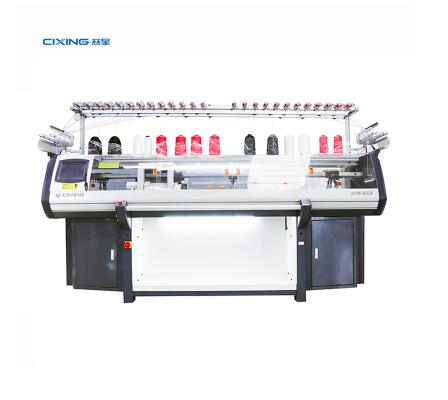How Flat Knitting Machines Are Transforming the Textile Industry
2024-09-05
Flat knitting machines have made a significant impact on the textile industry, revolutionizing how fabrics and garments are produced. Their versatility, efficiency, and advanced technology have opened up new possibilities for designers, manufacturers, and even consumers. In this blog, we’ll explore how flat knitting machines are transforming the textile industry and shaping the future of fashion, sportswear, home textiles, and technical fabrics.

---
1. Increased Customization and Design Flexibility
One of the most significant ways flat knitting machines are changing the textile industry is through the ability to customize fabric designs and create intricate patterns. Modern computerized flat knitting machines allow designers to program specific patterns, stitches, and textures directly into the machine. This digital capability enables the production of customized fabrics, from basic knits to highly detailed designs such as:
- Jacquard patterns
- Cables and lace
- Geometric shapes
- 3D structures
With this level of design flexibility, brands can quickly adapt to trends and offer personalized knitwear to their customers. Designers can create exclusive pieces without the need for manual labor-intensive knitting, reducing production time and costs while maintaining creative freedom.
---
2. Enhanced Production Efficiency
Flat knitting machines offer significant improvements in production efficiency compared to traditional hand knitting or even circular knitting. In the past, creating knitted garments was time-consuming and required significant manual input. However, with modern flat knitting machines, fabric production is faster, more precise, and less labor-intensive.
- Automated processes reduce the need for manual handling, speeding up production.
- The machines can produce seamless garments, eliminating the need for post-production sewing and reducing material waste.
- With the multi-gauge capability, machines can knit different yarn thicknesses and stitch types in a single piece, streamlining production.
This efficiency is especially important for mass production, where time-to-market is a critical factor. Brands can respond quickly to changing fashion trends, ensuring a competitive edge in the market.
---
3. Contribution to Sustainable Textile Manufacturing
The textile industry is facing growing pressure to adopt sustainable practices, and flat knitting machines are contributing significantly to these efforts. Zero-waste knitting has become a key advantage of flat knitting technology. By knitting garments or fabric panels to exact shapes, flat knitting machines minimize excess material that would otherwise be discarded as waste.
Additionally, computerized machines allow for more efficient use of yarn, reducing overproduction and material consumption. Combined with eco-friendly yarns like organic cotton, recycled polyester, or biodegradable materials, flat knitting machines play a crucial role in promoting sustainable fashion.
Key sustainability benefits include:
- Minimized fabric waste
- Energy-efficient production processes
- Reduction in water and chemical use in comparison to other textile manufacturing methods
---
4. Seamless Knitwear for Comfort and Functionality
One of the most notable transformations brought about by flat knitting machines is the ability to produce seamless garments. Seamless knitting technology eliminates seams in clothing, which results in improved comfort, fit, and appearance. This is particularly beneficial in the production of sportswear, intimate wear, and compression garments, where seams can cause irritation or discomfort.
In the sportswear industry, flat knitting machines are used to create engineered fabrics with varying levels of stretch, breathability, and compression, all within the same garment. For example, flat knitting technology allows manufacturers to knit ventilation zones or support structures directly into performance apparel, enhancing functionality and wearer comfort.
---
5. Smart Textiles and Wearable Technology
Flat knitting machines are also driving innovation in the field of smart textiles and wearable technology. The precision and customization offered by computerized flat knitting allow for the integration of electronic components, such as sensors and conductive yarns, into fabrics. These smart textiles can monitor body temperature, track movement, or provide other real-time feedback for applications in healthcare, sports, and military sectors.
With flat knitting machines, manufacturers can seamlessly embed these technologies into garments without sacrificing comfort or aesthetics. This has opened the door to the development of wearable tech that looks and feels like regular clothing but performs advanced functions.
---
6. Versatility Across Industries
Flat knitting machines are no longer limited to the fashion industry. Their ability to produce a wide range of fabrics has expanded their use across multiple sectors, including:
- Home textiles (e.g., blankets, cushion covers, upholstery)
- Medical textiles (e.g., compression garments, bandages)
- Automotive interiors (e.g., seat covers, fabric panels)
- Technical textiles for industrial applications
This versatility makes flat knitting machines invaluable in both traditional textile manufacturing and emerging fields, providing endless possibilities for innovation.
---
7. Shortened Supply Chains and On-Demand Production
With the advent of on-demand manufacturing, flat knitting machines have enabled brands to shift from traditional mass production models to more agile, small-batch, or even made-to-order systems. By producing garments locally and quickly, brands can reduce lead times, lower inventory costs, and minimize overproduction. This approach is particularly beneficial for online retailers or small fashion labels that want to offer customized or exclusive products without holding excessive stock.
The speed and precision of flat knitting machines allow for the quick production of garments as orders come in, making it easier to keep up with fast-changing consumer demands while reducing waste.
---
Conclusion
Flat knitting machines are transforming the textile industry by offering unparalleled design flexibility, improving production efficiency, promoting sustainable practices, and enabling the creation of seamless and smart textiles. Their versatility across various sectors, from fashion to technical textiles, makes them indispensable for manufacturers looking to innovate and stay competitive in today’s market. As technology continues to advance, flat knitting machines will undoubtedly play a central role in shaping the future of textile production.


